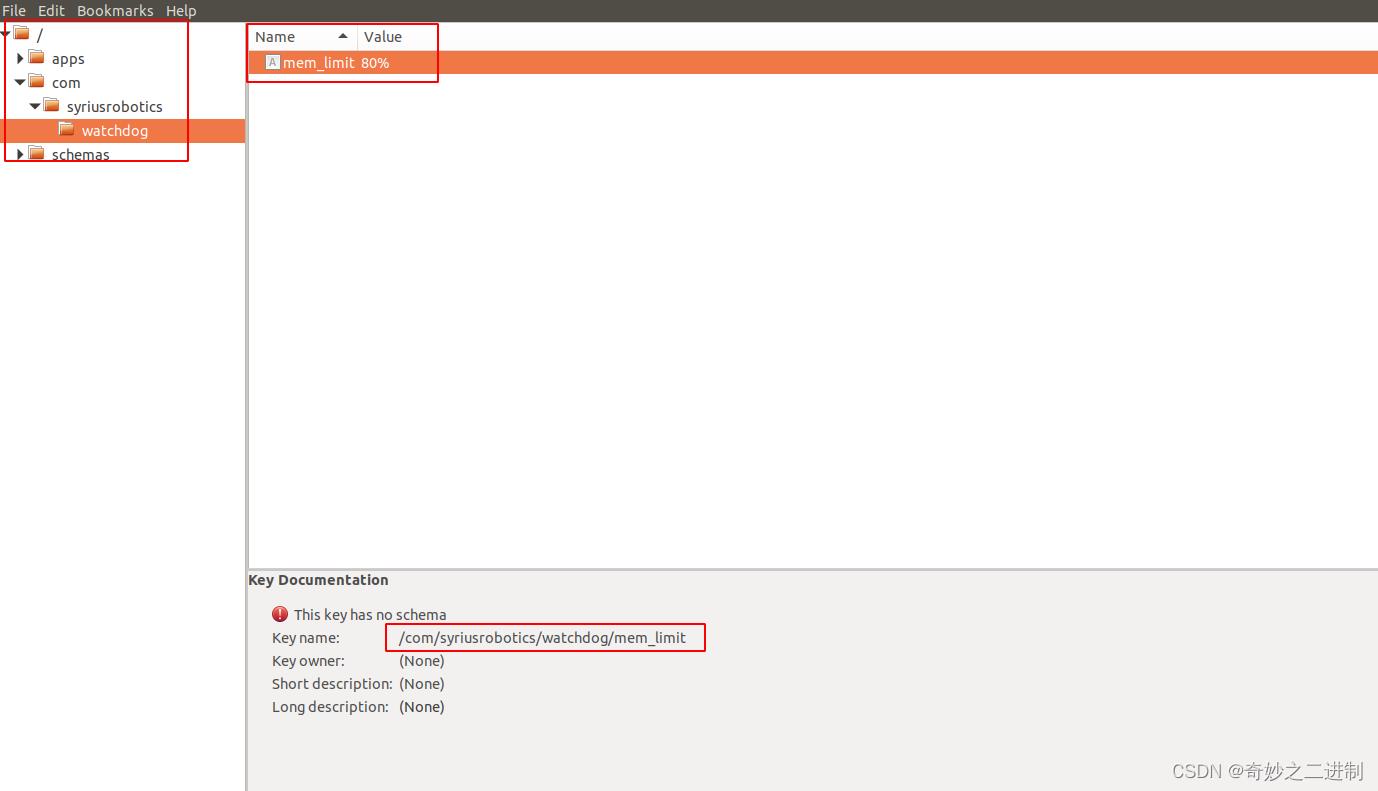gconf/dconf实战编程利用gconf库读写配置实战以及诸多配套工具演示
Posted 奇妙之二进制
tags:
篇首语:本文由小常识网(cha138.com)小编为大家整理,主要介绍了gconf/dconf实战编程利用gconf库读写配置实战以及诸多配套工具演示相关的知识,希望对你有一定的参考价值。
文章目录
准备工作
首先安装相应的库:
sudo apt install libgconf2-dev
检查是否安装成功:
victory@victory-ThinkPad-T490:~$ pkg-config --cflags --libs gconf-2.0
-pthread -I/usr/include/gconf/2 -I/usr/include/dbus-1.0 -I/usr/lib/x86_64-linux-gnu/dbus-1.0/include -I/usr/include/glib-2.0 -I/usr/lib/x86_64-linux-gnu/glib-2.0/include -lgconf-2 -lglib-2.0
安装gconftool工具:
gconf2
安装gconf-editor:
sudo apt install gconf-editor
用gconftool工具插入一个key-value用于读取。
victory@victory-ThinkPad-T490:~$ gconftool-2 --help-all
Usage:
gconftool-2 [OPTION…] - Tool to manipulate a GConf configuration
Help Options:
-h, --help Show help options
--help-all Show all help options
--help-client Show client options
--help-key-type Show key type options
--help-load Show load/save options
--help-server Show server options
--help-install Show installation options
--help-test Show test options
--help-schema Show schema options
Client options:
-s, --set Set a key to a value and sync. Use with --type.
-g, --get Print the value of a key to standard output.
-u, --unset Unset the keys on the command line
--recursive-unset Recursively unset all keys at or below the key/directory names on the command line
--toggle Toggles a boolean key.
-a, --all-entries Print all key/value pairs in a directory.
--all-dirs Print all subdirectories in a directory.
-R, --recursive-list Print all subdirectories and entries under a directory, recursively.
-S, --search-key Search for a key, recursively.
--search-key-regex Search for a key, recursively.
--short-docs Get the short doc string for a key
--long-docs Get the long doc string for a key
--dir-exists Return 0 if the directory exists, 2 if it does not.
--ignore-schema-defaults Ignore schema defaults when reading values.
Key type options:
-t, --type=int|bool|float|string|list|pair Specify the type of the value being set, or the type of the value a schema describes. Unique abbreviations OK.
-T, --get-type Print the data type of a key to standard output.
--get-list-size Get the number of elements in a list key.
--get-list-element Get a specific element from a list key, numerically indexed.
--list-type=int|bool|float|string Specify the type of the list value being set, or the type of the value a schema describes. Unique abbreviations OK.
--car-type=int|bool|float|string Specify the type of the car pair value being set, or the type of the value a schema describes. Unique abbreviations OK.
--cdr-type=int|bool|float|string Specify the type of the cdr pair value being set, or the type of the value a schema describes. Unique abbreviations OK.
Load/Save options:
--dump Dump to standard output an XML description of all entries under a directory, recursively.
--load Load from the specified file an XML description of values and set them relative to a directory.
--unload Unload a set of values described in an XML file.
Server options:
--get-default-source Get the name of the default source
--shutdown Shut down gconfd. DON'T USE THIS OPTION WITHOUT GOOD REASON.
-p, --ping Return 0 if gconfd is running, 2 if not.
--spawn Launch the configuration server (gconfd). (Normally happens automatically when needed.)
Installation options:
--install-schema-file=FILENAME Specify a schema file to be installed
--config-source=SOURCE Specify a configuration source to use rather than the default path
--direct Bypass server, and access the configuration database directly. Requires that gconfd is not running.
--makefile-install-rule Properly installs schema files on the command line into the database. Specify a custom configuration source in the GCONF_CONFIG_SOURCE environment variable, or set set the variable to an empty string to use the default configuration source.
--makefile-uninstall-rule Properly uninstalls schema files on the command line from the database. GCONF_CONFIG_SOURCE environment variable should be set to a non-default configuration source or set to the empty string to use the default.
Test options:
--break-key Torture-test an application by setting and unsetting a bunch of values of different types for keys on the command line.
--break-directory Torture-test an application by setting and unsetting a bunch of keys inside the directories on the command line.
Schema options:
--set-schema Set a schema and sync. Use with --short-desc, --long-desc, --owner, and --type.
--short-desc=DESCRIPTION Specify a short half-line description to go in a schema.
--long-desc=DESCRIPTION Specify a several-line description to go in a schema.
--owner=OWNER Specify the owner of a schema
--get-schema-name Get the name of the schema applied to this key
--apply-schema Specify the schema name followed by the key to apply the schema name to
--unapply-schema Remove any schema name applied to the given keys
Application Options:
-v, --version Print version
victory@victory-ThinkPad-T490:~$ gconftool-2 --type string -s /test hello
victory@victory-ThinkPad-T490:~$ gconftool-2 -g /test
hello
gconf的后端服务:
victory@victory-ThinkPad-T490:/usr$ cat ./share/dbus-1/services/org.gnome.GConf.service
[D-BUS Service]
Name=org.gnome.GConf
Exec=/usr/lib/x86_64-linux-gnu/gconf/gconfd-2
gconf采用层级xml的格式存储配置:
victory@victory-ThinkPad-T490:~/.gconf$ gconftool-2 -s --type int /com/syriusrobotics/watchdog/mem_limit 80
victory@victory-ThinkPad-T490:~/.gconf$ tree
.
└── com
├── %gconf.xml
└── syriusrobotics
├── %gconf.xml
└── watchdog
└── %gconf.xml
3 directories, 3 files
可读性非常好。需要注意的是,我们通过写入的配置,gconfd并不会立刻写入配置文件,它可能有自己的策略,例如定时或者退出时写入文件。
我们还可以gconf-editor工具可视化查看修改配置:

这个工具似乎有bug,/目录下添加的key无法显示。
编程
#include <gconf/gconf-client.h>
#include <stdio.h>
int main(int argc,char** argv)
GConfClient* client;
gchar* str;
gconf_init(argc, argv, NULL);
client = gconf_client_get_default();
str = gconf_client_get_string(client, "/test", NULL);
printf("/test=%s\\n",str);
编译:
gcc g.c `pkg-config --cflags --libs gconf-2.0`
写配置也很简单:
#include <gconf/gconf-client.h>
#include <stdio.h>
int main(int argc,char** argv)
GConfClient* client;
gconf_init(argc, argv, NULL);
client = gconf_client_get_default();
if(!gconf_client_set_string(client, "/test", "world",NULL))
printf("set string failed!");
return 0;
客户端和服务端采用dbus通信,我们可以使用dbus-monitor监听总线上的请求:
method call time=1659252379.022058 sender=:1.530 -> destination=org.gnome.GConf serial=7 path=/org/gnome/GConf/Server; interface=org.gnome.GConf.Server; member=GetDefaultDatabase
method return time=1659252379.030527 sender=:1.525 -> destination=:1.530 serial=97 reply_serial=7
object path "/org/gnome/GConf/Database/0"
method call time=1659252379.030599 sender=:1.530 -> destination=org.gnome.GConf serial=8 path=/org/gnome/GConf/Database/0; interface=org.gnome.GConf.Database; member=Set
string "/test"
struct
int32 1
string "world"
method return time=1659252379.030729 sender=:1.525 -> destination=:1.530 serial=98 reply_serial=8
服务端的dbus服务名为org.gnome.GConf。
以上是关于gconf/dconf实战编程利用gconf库读写配置实战以及诸多配套工具演示的主要内容,如果未能解决你的问题,请参考以下文章